Pastry technique: Make your own almond flour
December 17th, 2010 | 81 Comments
Right now I’m hard at work on a big, comprehensive French Macaron tutorial. It will be ready in a week or two, so I hope you look out for it.
Meanwhile, I’m going through almond flour as if I had a silo of it in the backyard. Somehow the grocery powers-that-be decided that us regular, hard-working folk will be charged a premium, nearly a mortgage payment, for packaged ground almonds. I guess the simple act of grinding almonds makes them worth twice as much? I’m staging a revolt.
Making your own takes a few minutes and you can get the same fine, light texture as the store-bought counterpart. It’s better to use a blender or a coffee grinder as opposed to a food processor because the result is more finely ground, and keeps the nuts from releasing too much of their natural oils. (But if you only have a food processor, that will still yield a workable result.)
And obviously you’re not limited to just almonds. You can dabble in pistachio flour, hazelnut flour, pecan flour, walnut flour. Some flours will end up oilier than others, depending on how fatty the nut is. Put on your lab coat, er, apron because this allows for flavor experimentation. Build a whole new flavor profile simply by substituting one nut flour for another in, say, a cake recipe. What used to be an almond cake with mixed berry compote, can now become a pistachio cake with sour cherry compote on a whim.
The other day I was glued to the food channel — surprise, surprise — and a famous chef was demonstrating a seafood recipe. I was hoping, perhaps foolishly, to learn a few tips, but he went through the recipe as though reading it out of a book. The instructions were presented as a list of actions — “score the fish, sear it, blanch the green beans, throw them in ice water.” Yes, the directions were all there, but you’d never understand the hows and whys of it from the way he was explaining it. He never touched on why he scored the fish, why he threw the vegetables in ice water. I should mention I used to work for this guy, and I was frustrated with his presentation. I knew he knew better.
It’s like telling a golfing novice that they need to hit the ball toward the hole. Ok, yes, I get that, but what’s the best way to stand, how hard do you hit the ball, which club is best to use? Without learning all the techniques, you’re just blindly going through the motions.
And simply following a recipe is also just going through the motions. How can anyone really learn to bake and do their own flavor variations, and alter a recipe to their liking if they don’t understand the hows and whys of how it works behind the scenes? How each ingredient contributes to the end result?
I’ve been doing recipe tutorials so far, and touching on techniques throughout each one, and as long as I have blood in my veins, those will continue. But I want to share more tips and techniques that I learned over the years so they can be applied to many recipes, not just the one I happen to be showcasing. I’ll be adding a METHODS navigation button on top so the list can be used as a reference. And the almond flour is first up.
Here are a few other inspired, useful tips and tricks that my fellow bloggers have posted. Definitely worth a look.
1. Elizabeth, over at Guilty Kitchen, shows how to make your own brown sugar, if you find yourself without.
2. MarzipanMom explains how to turn any cheesecake recipe into bars.
3. Joy the Baker, makes her own vanilla extract.
Almond Flour (or any nut flour)
Take some blanched nuts, almonds in this case (and they don’t even have to be blanched if you don’t mind the dark flecks you’ll get from the skins.) You can also try using roasted nuts for an earthier-tasting flour.
Throw them in a blender or coffee grinder. I use about a cup at a time. If the machine is overloaded, the blade may have a hard time reaching all the nuts, and the grind will be uneven.
Pulse a few times until they are finely ground. Don’t let it go for too long, otherwise the nuts will release too much of their oils and things will get pasty (which is ok, if you’re going for nut butter.)
Here’s a batch using unblanched nuts in a food processor. Still pretty good, but not as fine. The skins make the flour darker.
Once the nuts are ground, you can pass them through a sifter. I’m shakin’ the sifter.
Whatever larger pieces don’t make it through the sifter can be thrown back into the blender with the next batch of nuts for additional grinding. The finished flour can be stored in ziploc bags, either refrigerated for a month, or frozen for a few months. Make as much or as little as you need.
Pocket your savings for the cruise vacation.
Tags: almond flour, baking, how-to, nut flour, pastry
81 Responses to “Pastry technique: Make your own almond flour”
Post a Comment
Your E-Mail will be kept private. * = required fields.



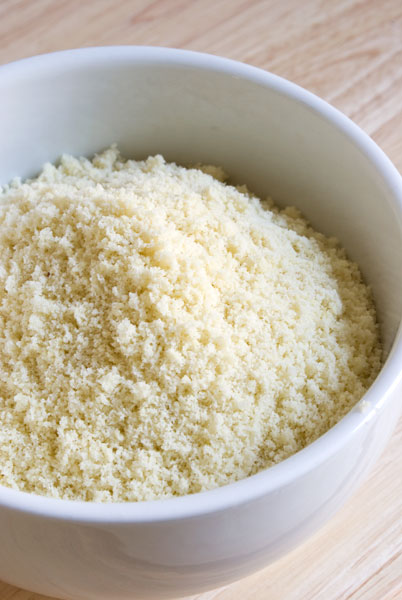
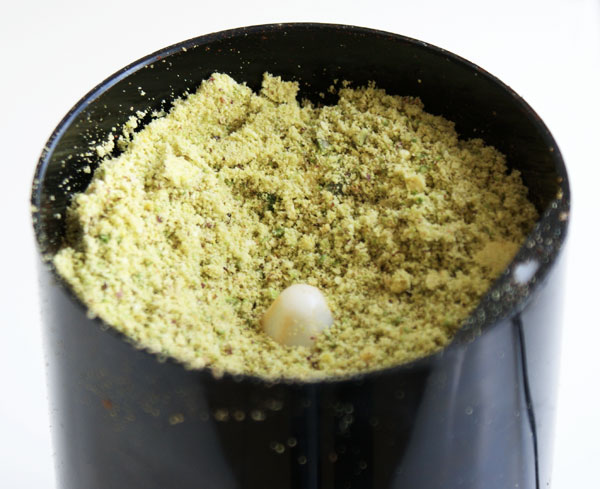
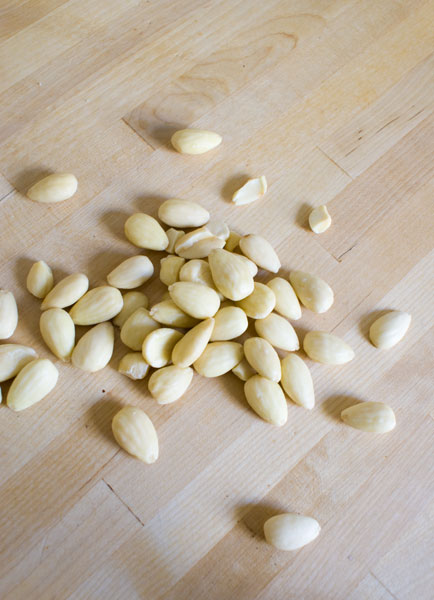
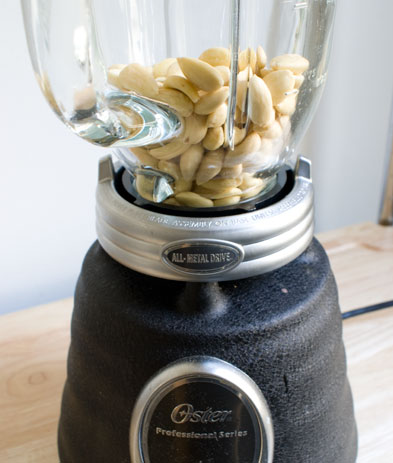
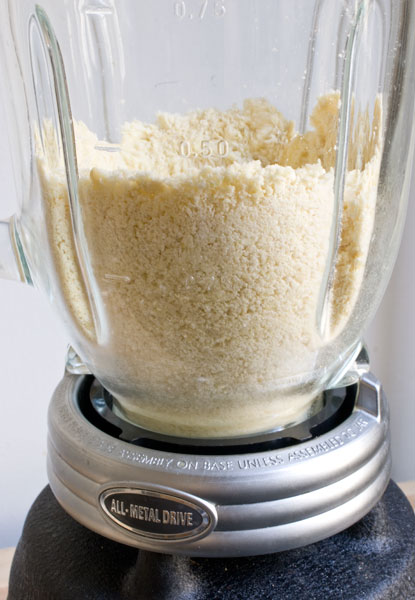
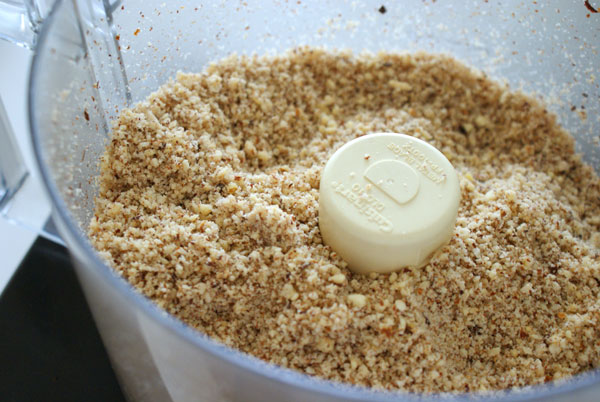
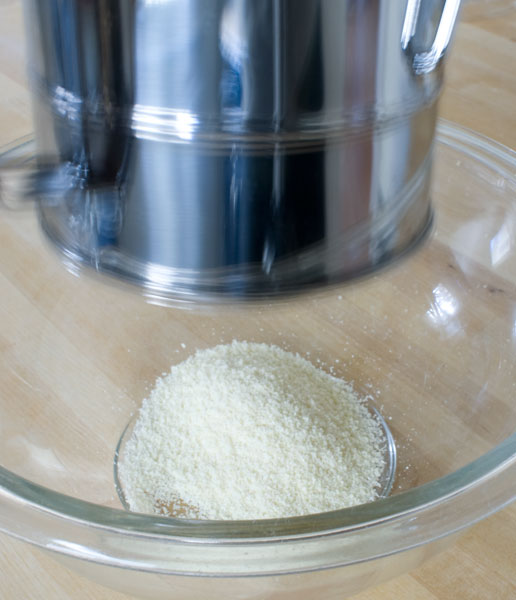



One thing I do to minimize the oily-ness when grinding nuts is to add a portion of the powdered sugar from the recipe with the nuts. Try starting out with a tablespoon of powdered sugar per cup or cup and a half of nut and grind/blend away. Another thing I’m planning on trying is to use maltodextrin powder. I think this will reduce the oily-ness even more than the powdered sugar. Maltodextrin is used in molecular gastronomy recipes to turn liquid fats into solid powders, which is where I got the idea from. I’m waiting for my order of maltodextrin to arrive to try it out.
Just beware the glycemic index of maltodextrine. Tends to trigger it.
Can I do this with wheat?
I am wondering if the reason for wanting the flour to be fine is that iti is being used in baking recipes? If I am using it as a coating for frying, I am thinking it might not need to be as fine. Is that correct? Bread crumbs and corn meal are used for coating, for example for fried fish. I made some almond “flour” in a prcessor, and as you have said it is not fine. Also, if I am using it for a coating would I still need to sift it?
Carol — You’re right, if you’re not baking with it, you can get away with a coarser texture. No need to sift it for frying either.
Sharda — You can grind your own wheat, yes.
Why does it need to be refrigerated? What’s the difference in this and regular flour? I’m new to cooking so I’m just curious.
thank you thank you. i was gutted when i saw my order i placed for almond flour and coconut flour didnt contain almond flour, you are a life saver and a penny saver too
Every recipe I’ve read for macaroons says to run your almond flour through the food processor to make it extra fine. Some have even said to “let it go” for a very long time. Mine turned to paste in under a minute. Is there any way to fix this? Why did it happen? How can I avoid this in the future? Thanks!
as per old story almonds are to be soaked in water for a night. Next day morning it should be made as paste after grinding on hard rock,. before taking. It should be taken only in winter season as it effects is very hot.
i am getting away from grains and into nut flours for baking so using nuts and seeds are great. i don’t have a processor but i can buy the nut flours but the recipes call for a cup amount of nuts to be processed and then used in the recipe. if i alreadly have the nut flours,i don’t know how many nuts it would take to make 1 cup of flour.
Hi. Maybe you can help me: I tried to make Macarrons with homemade almond flour…. it was a total failure, it cut the beaten egg-whites…. the egg-whites formed a beautiful, stiff mousse, and as I poured the almonds, they took the consistency of a warm milkshake. Where did I do the mistake?
Sharda, I use my wheat mill not only for fresh wheat flour, but also other grains such as rice (added to bread dough it gives the bread a more moist texture like cake). It’s fun to experiment!
This is such a fun blog! I am going to explore more now.
I make almond milk and then keep the pulp for Almond Flour.
Tell me please is there a difference between Almond Meal and Almond Flour?
What I see here makes me think this is Almond Meal.
My Almond Flour is totally different and I would love recipes for Almond Flour as I have lots left over after making my Almond Milk.
thanking you
Margaret 🙂
I am thrilled to find your website. I needed something to make almond flour. I was thinking about buying a food processor. Then, I saw a Cuisinart spice and nut grinder (this might be a good alternative to a coffee grinder). I already have a blender. I did not think grinding almonds in a blender would work. You are the first person I have found to suggest this.
Note: If you enjoy other recipes made with almond flour, go to Healing Cuisine by Elise. Elise has many healthy recipes. Thank you, again for your website.
Thanks for your advice on almond flour…..but I have a question!
I make almond milk and the by-product is the meal left over after I blanch, soak, and add water to the almonds, grind them very fine in a food processor and squeeze out the “milk”. (its the best almond milk I’ve ever had BTW!)
The meal is very damp. I was told to slow dry the left over meal in a very low oven and stir around until all the moisture is gone, let it cool, then I sift the meal as fine as I can and store.
I have been stock piling this flour and finally used it in a vegetarian cracker recipe that called for almond flour. The result was quite not as fine a cracker as I imagined, and I thought that trying to grind the flour finer and
leaving the moisture in my meal and re grinding it as you suggest in a coffee grinder would yield better results with my baking?
In a second batch I increased the amount of water/egg in the recipe and it had no effect on the texture.
Any suggestions would be appreciated,
Thanks!
Hi,
I see that you are using an oster blender. Most recipes for almond flour that I see are using a vitamix. Does the oster blender hold up to making nut flours? Are you able to get a fine grind with the oster? I would really love to save the money on a blender and spend it on almonds instead!
If a recipe calls for 1 cup of almonds ground in a food processor, how much almond flour does that make? I already have the ground product, so need a conversion please.
I just discovered this page. I am so excited and can’t wait to read through all of your other posts 🙂
Im not sure this site is still active but I’d like to know when following a recipe what adjustments have to be made? Like say you’re making banana bread and it calls for two cups of flour, do you also use 2 cups of almond flour and do you have to add other things to make it bind or whatever the need might be? Thank you.
One thing I do to reduce the oiliness is I soak blanched raw almonds/nuts for about three days then stick them in my nuwave oven or dehydrator on low heat (100-150F) for about 4-6hrs before grinding them. I don’t like using roasted nuts for flours because when I cook or bake them in the recipe they tend to get a burnt flavor to them.
I have ground Almonds at home can i make Almond butter with it ,,,, and if I can how do I do it ,,,Thanks Chris
I would like a recipie for pastry using almond flour for a pie . I am trying to follow a low cholestral diet . Thank you Sharon
how do u blanch the almonds
loving French Macarons have every time we go to Las Vegas.
well after watching a tutorial the other day, i now think i can make them, lol
went to the store and said yes almond flour, good grief it was 13.00 – i said don’t need almond flour, lol
jump on web once i got back in and came across your page.
thank you
I’m wondering if this methodology applies to pistachios. Noting obviously that you use the ‘skinless’ almonds for almond flour. Do you have to skin the pistachios?
I cannot eat grains any more so i need to come up with a different form of flour and gluten free doesnt cut it i cant digest any grains any longer. So for making a pastry form from almond flour does it work?
Rhett
Very hard to find the finely ground almond flour the professional patissiers use. I make my own.
I buy blanched almonds and slightly warm them, then wizz in the coffee grinder, pulsing a few times.
I sieve the powder to get enough for the recipe. Let’s say I’m making macarons and I need 150g of almond powder, I then add 150g of icing sugar to make my tant pour tant, sieving them together.
I then wizz the whole lot again in the coffee grinder and re-sieve.
Adding the icing sugar seems to help keep the almond powder dry and makes a very fine powder.
This produces very smooth macarons.
Any almond meal that is left after this process can be used to make sweet pastry, or marzipan, or any number of other cakes and desserts. No waste.
It is a bit of a ball ache, but the results speak for themselves.
Can you digest seeds? Buckwheat flour is a seed, sometimes I mix it with rice flour. I think almond might be too heavy for pastry but well worth a try. Sometimes mixing the hard to digest item with another ingredient helps the body process it-not always though.
Rhett, yes almond flour makes fantastic pastry. To be honest, I prefer it to other kinds of pastry. There are many great recipes online.
I followed this recipe and the results were perfect. My local store did not have almond flour, so I made my own and found it to be very easy. I will probably do this from now on, since it will cost less and I know it will be fresh each time I need it. Thanks for sharing your recipe and guidance.